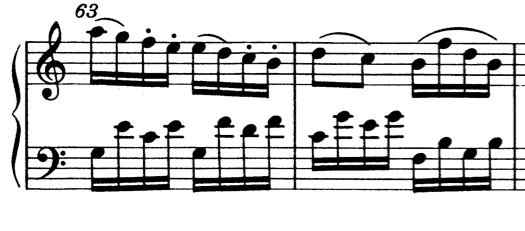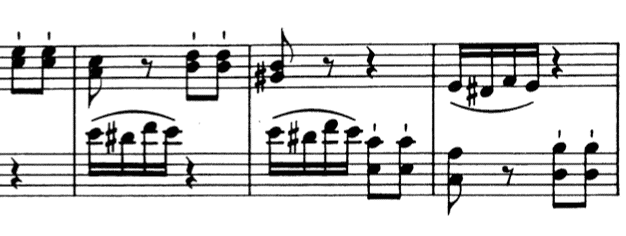In music we have two similar words to describe two musical pals, the staccato and the staccatissimo.
Each comes with its own notion, of course, but sometimes it is very difficult to distinguish between the two, especially when we listen to a performer playing a piece new to us.
Those two not so well-documented articulations can be used interchangeably depending on context, but also on the composer. Often, it can be hard to separate them even within the works of the same era. Depending on context, their implementation is usually very easy to decide, however.
Here’s an example that the staccato, can be translated differently within the same piece. In the second movement of Mozart’s famous K 545 sonata, we are asked to approach the staccato in a more subtle manner. Notice that in bar 58 of the second movement—the ligature does not exist in the urtext edition—the staccato should have a light and airy feel, almost as if the performer was trying to “featherly” lift the melodic line to the skies in this G major scale.

However, this time in the third movement of the same sonata the staccato on the semiquavers signals a more exciting moment, longing for the performer to thrill their audience as the piece bears towards its finale:

In both of those instances the staccato would inevitably sound differently. The performer cannot do much here, since the stories of both movements are contrasting. The performer should just let themselves go, and would feel adrift by the music, since the composer himself dictates the performance of this articulation through the speed, the rhythm and the gestalt of the sound of this passage.
Next, I compare Mozart to an eminent composer of the 21st century; a composer that has made his mark in the musical zeitgeist of the era, has infused his musical style widely and influenced one too many composers with his genius: me. You: (?) The piece I use in the example below is the Little Knight’s Horse from my collection of pieces Scenes From A Child’s Mind, that you should buy at once if you want to become an amazing pianist! ◔_◔
On we go. In the K 545 sonata, the staccatissimo in the urtext edition is vastly different to the staccatissimo in “Little Knight’s Horse”:
Here, Mozart’s staccatissimo compared to a contemporary work—a work played on the modern piano of course, a piano that would have been considered as an imaginary conception in Mozart’s era—will simply sound too different: Mozart’s has a more down-to-earth feel and a more sensible aftertouch, compared to the pointy stacatissimo pertained to the style that Little Knight’s Horse wants to achieve in its unconstrained-type of sound.
Below, Mozart’s staccatissimo is in actuality a more exciting staccato; often Mozart wrote staccato, but wrote the word “staccatissimo” next to it to simply imply that the passage is still staccato, but… even more staccato:

The staccato on Little Knight’s Horse, however, is more forceful and not as tender as it would have been on Mozart’s delicate Keyboard instruments; it requires a more abrupt sound and longs for today’s mighty-sounding, rigidly-manufactured piano:

So, what is the true difference between the two in mathematical terms, I hear you ask. Well, If I was forced to answer this today, and only if my life was depending on it, I would just say that “staccatissimo is when you hold a note for equally or less than a quarter of its original value”. And yes, it would just be simple to say that it is a shorter staccato, but always bear in mind that it really depends on the context.
I hope this makes sense. If it doesn’t, well, it doesn’t matter. This is just an article, and you won’t learn the piano from reading it, anyway. So, off you go! Go and do some practising already.
Copyright © 29 of February 2020 by Nikos Kokkinis
===========

